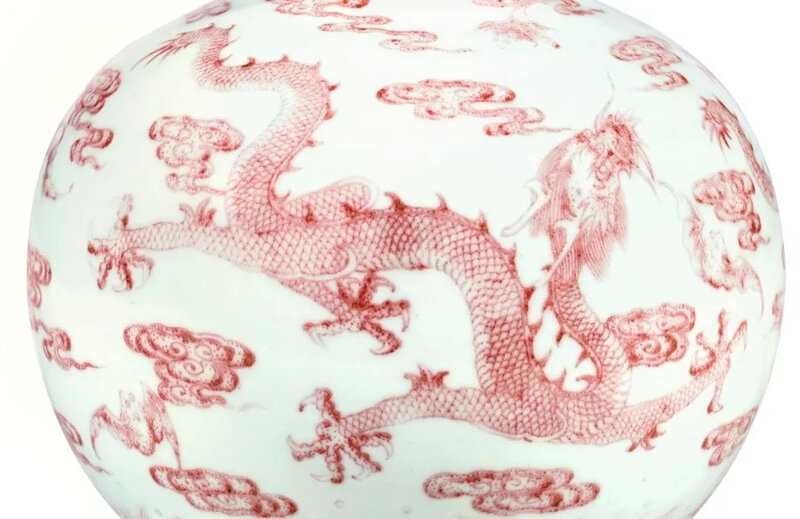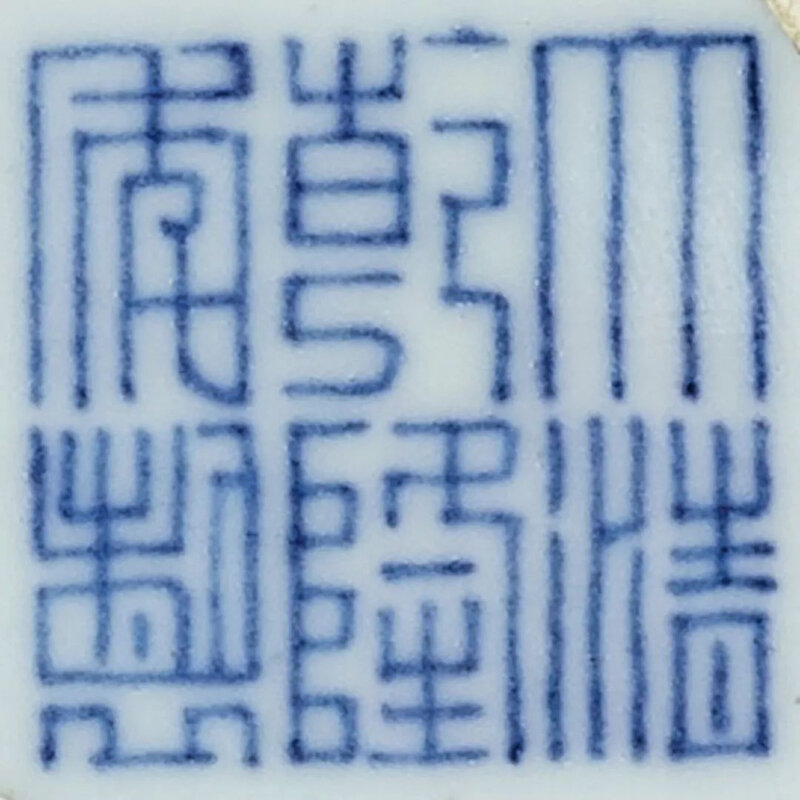Sotheby's. Important Chinese Art, Hong Kong, 03 Apr 2018, 02:00 PM
An extremely fine and rare copper-red 'dragon' double-gourd vase, Seal mark and period of Qianlong (1736-1795)
Lot 3203. An extremely fine and rare copper-red 'dragon' double-gourd vase, Seal mark and period of Qianlong (1736-1795); 31.3 cm, 12 1/4 in. Estimate 8,000,000 — 12,000,000 HKD (834,547 - 1,251,821 EUR). Lot Sold 9,720,000 HKD (1,005,770 EUR). © Sotheby's 2018
skilfully potted with a larger globular bulb gracefully sweeping up to a smaller upper bulb, rising to a slender neck and flared rim, the lower bulb finely painted in copper red with a ferocious five-clawed dragon shown in full frontal position encircling a 'flaming pearl', flanked by a pair of dragons striding amidst lingzhi cloud swirls and bats above a band of crashing waves skirting the foot, the upper bulb decorated with two further dragons in mutual pursuit of a 'flaming pearl' amidst clouds and bats, all below a ruyi band collaring the mouth-rim, the countersunk base inscribed in underglaze blue with a six-character seal mark.
Provenance: Sotheby's Hong Kong, 17th November 1975, lot 222.
Collection of T.Y. Chao (1912-1999).
Sotheby's Hong Kong, 18th November 1986, lot 71.
Exhibited: One Hundred Selected Pieces of Chingtechen Porcelain of the Ming and Ch'ing Dynasties from the Collection of the T.Y. Chao Family Foundation, Hong Kong Museum of Art, Hong Kong, 1978, cat. no. 78.
Note: Magnificently painted with five dragons leaping through lingzhi clouds above crashing waves, this vase is a testament to the strength of the Qianlong reign. It boasts the formidable power of the Emperor through the fierce five-clawed dragons and the revitalisation of the imperial kilns at Jingdezhen. With the establishment of the Qing dynasty, a concentrated renewal of imperial patronage sparked a fresh wave of porcelain production, resulting in a fresh wave of creativity and the invention and improvement of established techniques, such as perfecting the use of copper-red pigment.
Only one companion piece to this vase appears to be recorded, sold in our London rooms, 20th June 2001, lot 23 and again in these rooms, 9th November 2007, lot 1216 (fig. 1). The rarity of these vases is further evidenced in the reign mark, whereby the radical in zhi is turned to face inwards. This mark is found on a comparatively smaller number of porcelains, including another copper-red double-gourd vase of similar form but with a more compressed lower bulb, decorated with chilong medallions, sold in these rooms, 15th May 1990, lot 193; and a pair in the Sui'anshi (Room of Finding Peace) in theYangxingdian (Hall of Cultivating Mind) in the Forbidden City, Beijing, where the Emperor is said to have rested during periods of fasting, illustrated in situ in Qingdai gongting shenghuo/ Life in the Forbidden City, Hong Kong, 1985, pl. 177. A vase with this mark, similarly rendered in copper red with a side-facing dragon amongst branches of lingzhi, from the Qing Court collection and still in Beijing, is included in The Complete Collection of Treasures of the Palace Museum. Blue and White Porcelain with Underglazed Red (III), Shanghai, 2000, pl. 174, together with a covered jar, but with a different Qianlong reign mark, pl. 178.
Copper-red ‘dragon’ double-gourd vase, seal mark and period of Qianlong, Sotheby’s Hong Kong, 9th November 2007, lot 1216.
Notoriously difficult to apply and fire with success, copper red required precise control of the firing temperature and the atmosphere inside the kiln. The resulting tone of the red was particularly important to the Qianlong Emperor, possibly due to the auspicious connotation of the colour. His demand for excellence is noted in a court record of 1738, where he rated the colour of a copper-red meiping with dragon design as not good enough (Feng Xianming, Annotated Collection of Historical Documents on Ancient Chinese Ceramics, Taipei, 2000, p. 232). Further evidence of the technical proficiency of the craftsmen of this era is evident in the masterful application of the pigment through thin, almost pencilled, lines and stippling to create a rich and sumptuous effect similar to the 'heaping and piling' of early Ming blue and white porcelain.
Compare a similarly rendered moonflask painted in copper red with four dragons surrounding a central front-facing dragon, the reverse with four further dragons, all amongst scrolling clouds above crashing waves at the foot and a ruyi band at the neck, with a Qianlong reign mark and of the period, illustrated in The Leshantang Collection of Chinese Porcelain, Taipei, 2005, pl. 47, and sold in these rooms, 1st May 2001, lot 538. Copper-red dragon vases are known from as early as the late Yuan dynasty (1279-1368) and Hongwu reign (1368-1398); see a pear-shaped vase with handles, attributed to the Hongwu period, in the Shanghai Museum, Shanghai, published in The Complete Works of Chinese Ceramics, vol. 12, Shanghai, 2000, pl. 223; and a meiping sold in these rooms, 13th November 1990, lot 125.

/https%3A%2F%2Fprofilepics.canalblog.com%2Fprofilepics%2F1%2F0%2F100183.jpg)
/https%3A%2F%2Fstorage.canalblog.com%2F03%2F02%2F119589%2F96711876_o.jpg)
/https%3A%2F%2Fstorage.canalblog.com%2F11%2F31%2F119589%2F94773502_o.jpg)
/https%3A%2F%2Fstorage.canalblog.com%2F20%2F83%2F119589%2F94772815_o.jpg)
/https%3A%2F%2Fstorage.canalblog.com%2F26%2F72%2F119589%2F75604929_o.jpg)
/https%3A%2F%2Fstorage.canalblog.com%2F59%2F60%2F119589%2F26458628_o.jpg)







/http%3A%2F%2Fstorage.canalblog.com%2F88%2F26%2F119589%2F129337200_o.jpg)
/http%3A%2F%2Fstorage.canalblog.com%2F51%2F59%2F119589%2F128976423_o.jpg)
/http%3A%2F%2Fstorage.canalblog.com%2F30%2F27%2F119589%2F128677718_o.jpg)